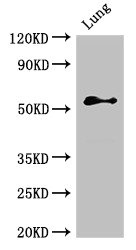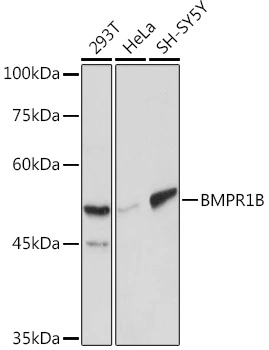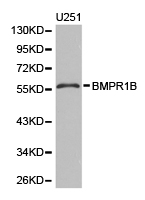![IHC-P analysis of formalin fixed human placenta tissue using GTX52506 BMPR1B antibody [3E12]. IHC-P analysis of formalin fixed human placenta tissue using GTX52506 BMPR1B antibody [3E12].](https://www.genetex.com/upload/website/prouct_img/normal/GTX52506/GTX52506_20191119_IHC-P_w_23060900_591.webp)
IHC-P analysis of formalin fixed human placenta tissue using GTX52506 BMPR1B antibody [3E12].
BMPR1B antibody [3E12]
GTX52506
ApplicationsWestern Blot, ImmunoHistoChemistry, ImmunoHistoChemistry Paraffin
Product group Antibodies
TargetBMPR1B
Overview
- SupplierGeneTex
- Product NameBMPR1B antibody [3E12]
- Delivery Days Customer9
- Application Supplier NoteWB: 1:100 - 1:1000. *Optimal dilutions/concentrations should be determined by the researcher.Not tested in other applications.
- ApplicationsWestern Blot, ImmunoHistoChemistry, ImmunoHistoChemistry Paraffin
- CertificationResearch Use Only
- ClonalityMonoclonal
- Concentration200 ug/ml
- ConjugateUnconjugated
- Gene ID658
- Target nameBMPR1B
- Target descriptionbone morphogenetic protein receptor type 1B
- Target synonymsALK-6, ALK6, AMD3, AMDD, BDA1D, BDA2, CDw293, bone morphogenetic protein receptor type-1B, BMP type-1B receptor, BMPR-1B, activin receptor-like kinase 6, bone morphogenetic protein receptor, type IB, serine/threonine receptor kinase
- HostMouse
- IsotypeIgG2
- Protein IDO00238
- Protein NameBone morphogenetic protein receptor type-1B
- Scientific DescriptionThis gene encodes a member of the bone morphogenetic protein (BMP) receptor family of transmembrane serine/threonine kinases. The ligands of this receptor are BMPs, which are members of the TGF-beta superfamily. BMPs are involved in endochondral bone formation and embryogenesis. These proteins transduce their signals through the formation of heteromeric complexes of 2 different types of serine (threonine) kinase receptors: type I receptors of about 50-55 kD and type II receptors of about 70-80 kD. Type II receptors bind ligands in the absence of type I receptors, but they require their respective type I receptors for signaling, whereas type I receptors require their respective type II receptors for ligand binding. Mutations in this gene have been associated with primary pulmonary hypertension. Several transcript variants encoding two different isoforms have been found for this gene. [provided by RefSeq, Feb 2012]
- Storage Instruction-20°C or -80°C,2°C to 8°C
- UNSPSC12352203






